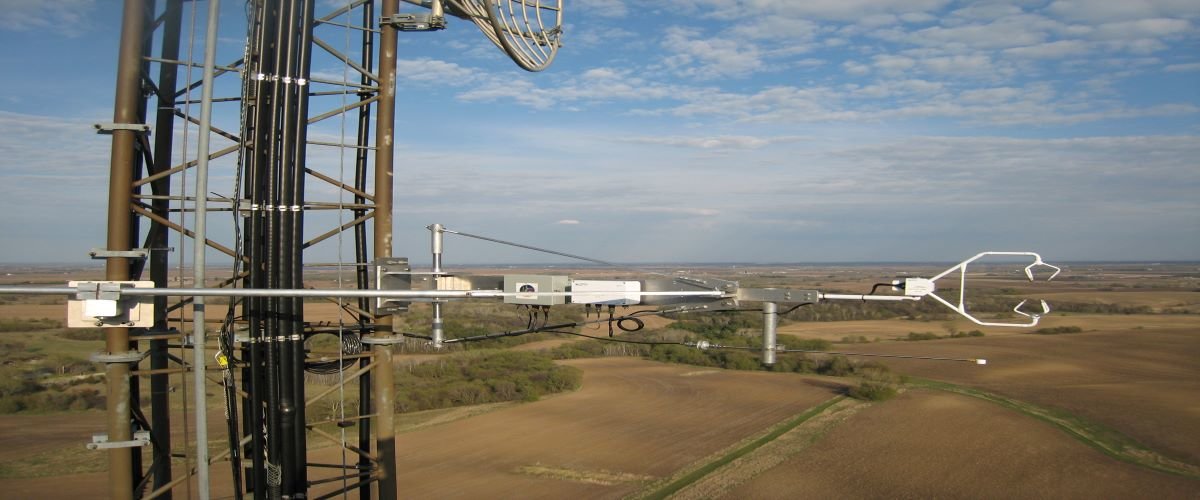
Climate eye in the sky
University of Minnesota's Tall Tower Trace Gas Observatory has amassed 15 years of data about climate change across the U.S. corn belt

There's a tower near the University of Minnesota's Twin Cities campus that's doing much more than broadcasting music and radio programs. It's using trace gas sensors to measure gases such as carbon dioxide, nitrous oxide, ammonia, and methane.
Located just south of the Minneapolis-Saint Paul metro area, the U of M's Tall Tower Trace Gas Observatory operates off the same tower as Minnesota Public Radio (MPR, KCMP 89.3 "The Current").
When Tim Griffis, PhD, arrived on campus in 2002, he immediately took note of the tower. As a professor in the Department of Water, Soil and Climate in the College of Food, Agricultural and Natural Resource Sciences (CFANS), he was studying fluxes of greenhouse gases between agricultural systems and the atmosphere.
“We can take measurements from near the ground, but a very tall tower gives you an ‘eye in the sky’ perspective of what regional emissions are doing over time,” he said. “I got ahold of an engineer at MPR and asked if we could add instruments to the tower to measure some of these gases, and he was willing to work with us.”
With funding from a National Science Foundation career award, Griffis obtained the equipment and hired professional climbers to install the instrumentation. It was the beginning of a quest to understand how greenhouse gases were changing over time in the Upper Midwest, to what extent this was caused by climate variations and the impact of agricultural activities.
Budgets and benchmarks
The UMN tall tower is part of a network of such towers operating across the United States and globally. Each tower aims to understand the “flux” of greenhouse gases for a given region; in other words, how much is going into the atmosphere versus how much is being taken up by the land surface.
“Think of this like you would a bank budget,” said Griffis. “You keep track of how much is going out of the account and how much is coming in, and the goal is to be accumulating more than you’re releasing. The same goes for greenhouse gas emissions. We want to gain carbon and reduce the amount going into the atmosphere.”
He explained that if you put all the towers together, researchers can start to estimate global budgets for emissions. The data that he and his team have gathered over the past 15 years has been made publicly available for use in developing emission estimates, testing biogeochemical and climate models and tracking climate change. Most importantly, according to Griffis, the long-term record is key to establishing a benchmark for emissions from the U.S. corn belt.
“The long-term data is what’s so important for addressing climate change,” he said. “If we set policies to reduce emissions, this data can help assess whether these policies are making a difference. You have to establish a robust benchmark.”
By combining the data from the trace gas sensors with meteorological inputs, Griffis and team can run it through an atmospheric transport model that calculates where the particles came from. The model runs backwards in time, pinpointing a source location that contributed to the gases observed at the tall tower. That’s how the tower can identify the methane from cows in Illinois or ammonia from pig manure in Iowa, for example.
A long-term endeavor
Since its inception, the tower has been adding instrumentation and capabilities as funding becomes available. Most recently, Griffis received a National Science Foundation grant which will allow him to measure isotopes of nitrous oxide to better understand their source characteristics.
Nitrous oxide is of particular interest to Griffis because it’s about 300 times more powerful than carbon dioxide on a per-molecule basis and it’s implicated in stratospheric ozone depletion.
“Each year we add 6-7 tera-grams of synthetic nitrogen to the U.S. corn belt in the form of fertilizer,” he said. “Once it goes into the ground, a fraction of it will go into the atmosphere as a by-product of denitrification and nitrification. This research will help us address the key question of how much is going into the atmosphere, and what are the key sources and processes that control its temporal variability.”
The isotope signals will provide forensic evidence that his team can use to diagnose the key sources, and this should help mitigate the problem in the future. Griffis says that such benchmarks will be essential for evaluating the effectiveness of the mitigation strategies.
The three-year grant includes the support of an undergraduate research assistant. She joins Griffis’ small team of graduate students and post-doctorate researchers who help maintain the tower, run the models and interpret the data.
“We are all passionate about being able to maintain a long-term record of Earth’s most important greenhouse gases,” said Griffis. “It’s an opportunity to contribute unique and meaningful data to advance climate change solutions globally.”





